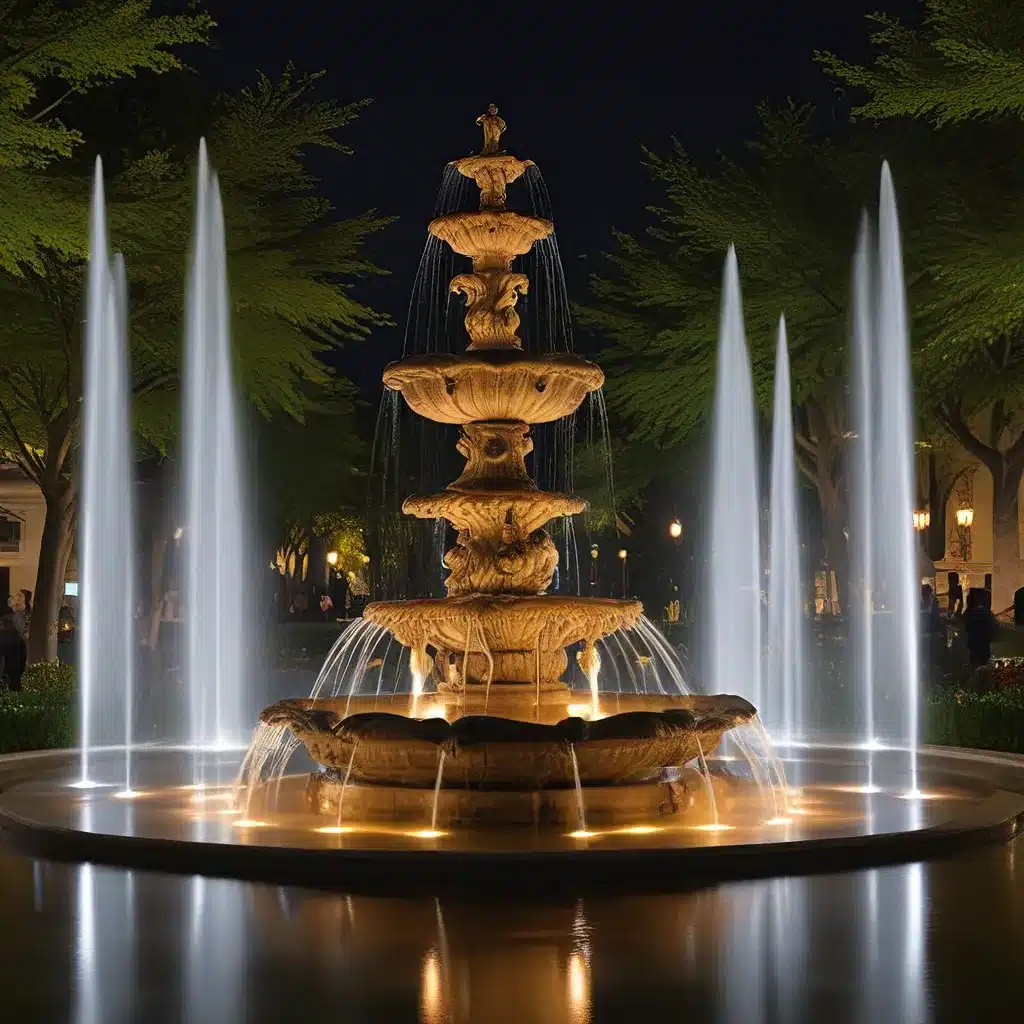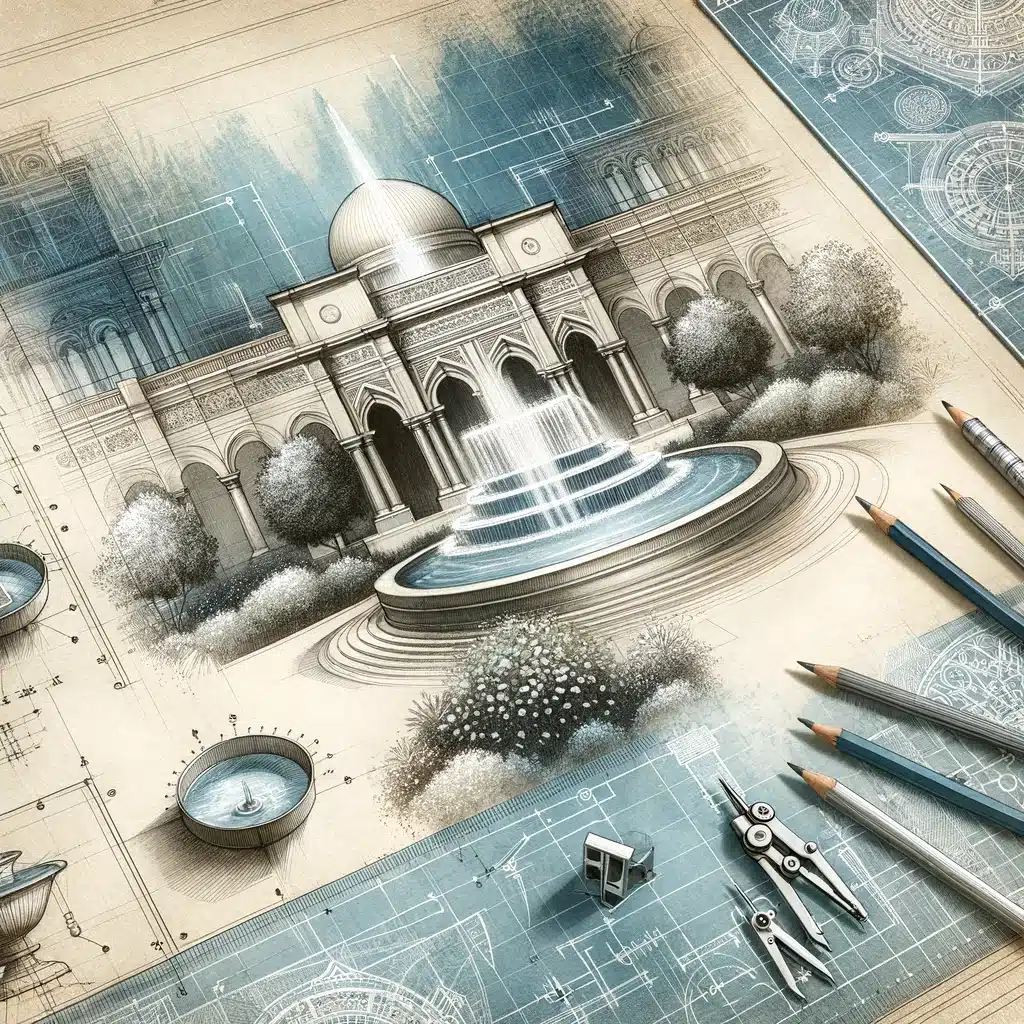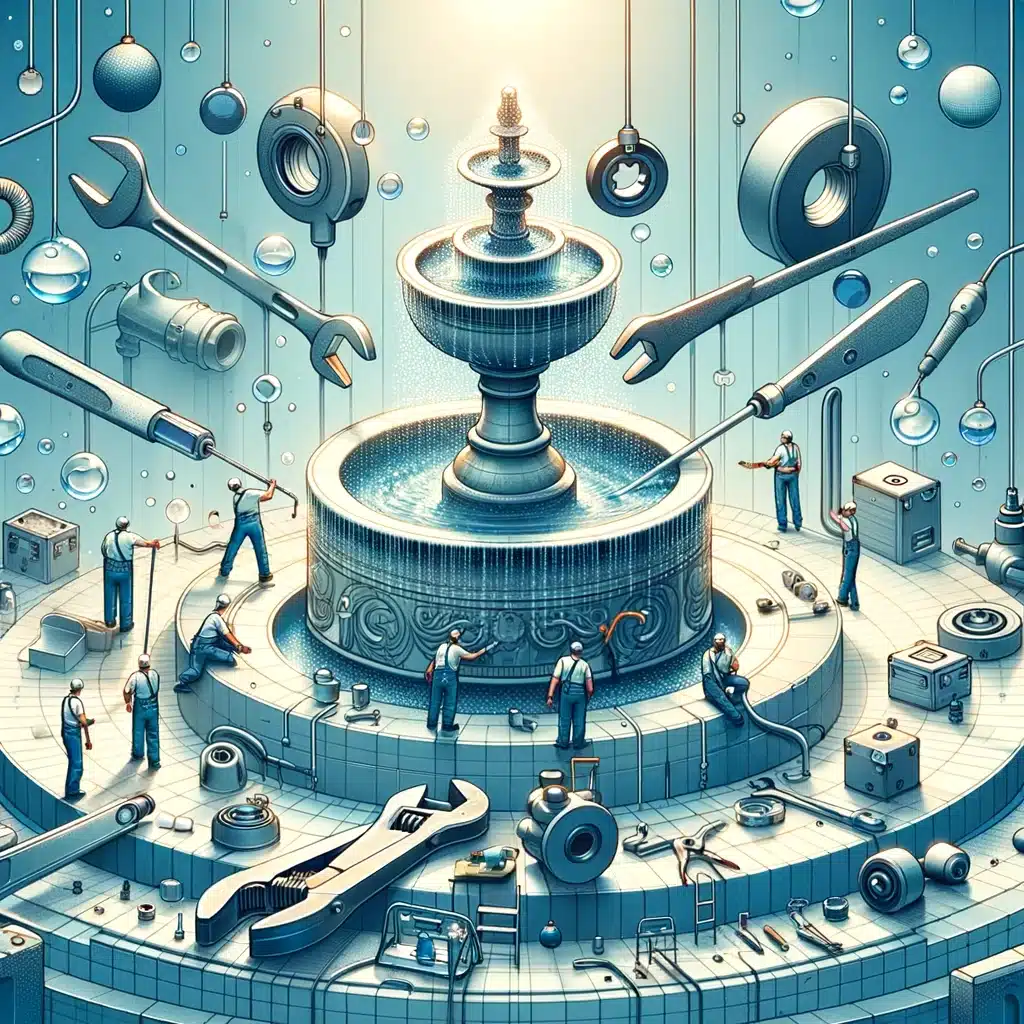
Fountain Design Essentials – Welcome to Fountain Lights
Fountain Design Essentials – Welcome to Fountain Lights
Water fountains have long been a prominent architectural and artistic feature in public spaces around the world. The soothing sound of cascading water combined with the allure of dynamic spray patterns can transform any landscape into an inviting oasis. When designed well, fountains become beloved landmarks and natural gathering places within a community.
However, the construction of an aesthetically pleasing, functioning water feature requires careful planning and access to specialized fountain equipment. From powerful pumps and lighting to intricately designed nozzles, the technology and hardware needed to build fountains can be an expensive investment. This is where working with a fountain equipment rental company becomes a wise and cost-effective option.
In this comprehensive guide, we will explore the integral relationship between beautiful fountain design and utilising rental equipment. Gaining insight into key technical areas like hydraulics, lighting, nozzle patterns, pumps, and maintenance will illustrate the vital role that equipment rentals play in executing unique water features. Whether designing a new installation or upgrading an existing fountain, understanding principles of equipment use, safety protocols, troubleshooting, and innovative design trends allows you to optimize aesthetics while saving on costs.
By learning how to strategically incorporate equipment rental into your fountain projects, you can craft sustainable, visually stunning water elements that stand the test of time. Let’s dive in!
When embarking on a new fountain project, the foundation of your design lies in identifying the key aspirations and physical parameters. Determining the desired aesthetic style, dimensions, water effects, location, budget, and purpose are essential first steps.

The type of fountain you choose can range from simple drinking fountains to dramatic dancing fountains, where water leaps and dances to music. More common designs include:
The purpose is also critical. Decorative fountains exist for aesthetics, while interactive fountains encourage play. Understanding context informs size, visibility, safety, accessibility, and more.
When drafting an initial design, consider practical factors like:
Researching the area’s climate, codes, infrastructure, and environment will allow you to tailor the fountain to its surroundings.
The architecture and artistic design of a fountain bring a unique personality to the space while showcasing the water’s natural magnificence. Fountains can provide a stunning centerpiece to plazas, enhance building facades, act as calming accents to gardens, and more.
Fountains borrow from varied design movements and eras, including:
The architecture should complement the surrounding infrastructure and landscape.
Fountains are truly an art form combining architecture, sculpture, and design. Key artistic components include:
Lighting also amplifies beauty, which we will cover more in depth shortly.
A cohesive theme creates harmony between the water effects, landscape, and architectural details. Popular themes include:
By thoughtfully blending architecture, art, and thematic style, fountains exhibit their own unique flair.
The behind-the-scenes hydraulics that power fountains are just as vital as aesthetics. Understanding key hydraulic components allows you to design reliable systems to bring your water features to life.
Fountains require a clean water feed free of particles that could clog components. Typical supply sources:
Pumps provide the pressure and flow to propel water through nozzle designs. Consider:
We will cover optimal pump selection in more detail later on.
Durable, food-grade PVC is the standard for fountain plumbing. Key components include:
Proper slope, leak-proof glues and seals, and isolation valves enable smooth water flow.
Filtration removes particles that could clog nozzles and damage pumps:
The filtration system’s micron rating should match fountain feature sizes.
Disinfection and water treatments prevent bacterial buildup:
Proper water treatment enhances fountain longevity.
Consistent fountain maintenance preserves functionality, aesthetics, and water quality over decades of operation. Developing a strict maintenance plan is a must.

By sticking to a strict maintenance schedule, your fountain can provide beauty and serenity for generations. A little effort goes a long way!
The heart of a fountain’s allure lies in the patterns created by water emerging from uniquely designed nozzles. The nozzle choice directly influences the water’s movement, volume, size, angle, and other properties.
Subtle shape variations create distinct effects. Round is common but squared nozzles make linear sheets.
Nozzle orifice shape sculpts the water’s path:
Fan sprays make gentle pools while streaming jets shoot up dramatically.
Water acceleration method affects flow volume, pressure, and velocity:
Each method creates unique hydraulic signatures.
Nozzle housings range from plastics to metals:
Robust metals better withstand water’s forces but may cost more.
The nozzle combinations are endless – craft water features unique to your vision by harnessing nozzle design fundamentals.
Choosing the appropriate pump is critical to producing desired fountain effects reliably and efficiently. Consider key factors:
Volumetric pumps work for basic fountains, while dynamic/displacement pumps allow more dramatic spray heights.
Match pump capacity to your fountain’s:
Oversizing wastes energy, while undersizing inhibits effects.
Consider pump motor efficiency ratings:
Go beyond basic single speed pumps when possible for energy savings.
Maximize fountain up-time and longevity:
Robust construction ensures reliable, low-maintenance operation.
By selecting the optimal pump early and understanding key specifications, you can bring your fountain design to life efficiently. Don’t settle for undersized units or overpay for overpowered pumps.
Proper lighting transforms fountains from day to night, amplifying the interplay between water and illumination. Lighting enhances aesthetic drama and extends the enjoyment hours of fountains.
Provides attractive light across the entire fountain for visibility:
Ambient lighting allows fountains to shimmer softly at night.
Strategic lighting highlights specific fountain elements:
Accent lighting creates dramatic contrast and depth.
Advanced lighting effects like:
Take lighting to the next level with technology integration.
Properly designed lighting transforms fountains into a canvas for your creative vision. Work closely with lighting designers and rental suppliers to build stunning illumination tailored specifically for your fountain. The possibilities are truly endless!
From initial build-out to ongoing upkeep, having access to specialized fountain rental equipment on-demand provides critical flexibility and cost savings versus purchasing outright.
Onsite pump rentals allow specifying ideal pumps for temporary setups like:
Pump rentals prevent buying unnecessary pumps outright.
Renting specialty water treatment systems prevents permanent capital costs:
Customize water quality solutions for temporary needs.
Specialty lighting rentals create dramatic displays:
Achieve spectacular custom lighting without permanent fixture costs. Rentals enable flexibility.
When approaching fountain projects, deciding between outright purchasing equipment or temporary rental requires weighing key factors:
Purchase burdens you with ownership duties.
Rentals offer financial flexibility and convenience.
If equipment is needed:
Analyze break-even timeframes when unsure.
By understanding equipment costs and evaluating project timelines, fountain designers can optimally balance purchases and rentals for maximum value. Mix and match as needed!
When managing equipment onsite, strict safety practices protect workers, the public, and the jobsite. Fountain components can pose hazards if improperly handled.
Prevent damage and accidents with cautious equipment mobilization.
Vigilance prevents electronics mishaps and water hazards.
Strict protocols prevent human errors during maintenance.
Ongoing vigilance shields fountain visitors from harm.
By making fountain safety an uncompromising priority, companies create professional, liability-free relationships built on trust.
Sustainable design minimizes fountains’ environmental impact through energy efficiency, water conservation, and eco-conscious construction.
Energy-wise systems lower ongoing resource consumption.
Reducing water waste is paramount.
Construction materials make a substantial impact.
By integrating eco-friendly solutions throughout your project, fountains can nourish communities rather than taxing the environment.
State-of-the-art materials provide designers with incredible freedom to build dramatically innovative fountains. Advanced fabrication and composites enable visions impossible decades ago.
Metals create stunning sculptural centerpieces.
Blend materials for structural innovations.
Protect fountain surfaces while simplifying maintenance.
Technology empowers designers to build once unimaginable water forms. The future holds even greater possibilities as material science continues advancing!
Managing fountain pressure requires balancing multiple factors for optimal flow. Too little pressure causes weak flow, while excessive pressure stresses components.
Pressure changes in different fountain zones. Consider:
Measure psi across all zones for insights.
Use in-line valves, controllers, and other methods:
Actively managing pressure prevents problems.
Vigilant monitoring ensures optimal pressure balancing.
Smoothly modulating all aspects of fountain pressure eliminates problems, improves equipment longevity, and keeps water flowing perfectly.
When fountain problems inevitably arise, methodically diagnosing issues speeds resolution. Common equipment failures include:
Service pumps per manufacturer recommendations.
Clean and inspect nozzles if water patterns degrade.
Keep water moving smoothly throughout the system.
Proactively addressing issues quickly prevents cascading failures. Learn your fountain’s quirks!
Outdoor fountains require adapting maintenance to handle weather fluctuations throughout the year. Look ahead to prevent avoidable seasonal issues.
Thoroughly rehabilitate systems after winter.
Prevent summer problems before they arise.
Take proactive steps to protect equipment.
Thorough winterization prevents catastrophic damage. Don’t neglect pre-winter planning!
Subtle nuances in nozzle specifications noticeably alter fountain spray characteristics and performance. Consider key factors when selecting nozzles:
Orifice ratios profoundly impact the hydraulic signature.
Inside nozzle geometry shapes water discharge patterns.
Friction properties alter velocity and aeration.
Orientation possibilities are infinite.
Although small, nozzles create the diversity and artistry of fountain displays. Their design intricacies provide creative opportunities.
Specialized fountain pumps continue improving to provide reliability, energy efficiency, and functionality. Understanding pump technology helps select ideal models.
Smarter components improve productivity.
New pumping methods enhance versatility.
Focusing on longevity and strength.
Smart features simplify fountain pump use, maintenance, and connectivity.
The future holds exciting potential for pumping technology to become even more tailor-made for reliable, efficient fountain service.
Innovative lighting strategies and technology impart stunning visual impact to fountains. Dynamic and colourful lighting transforms water into a glowing canvas.
LEDs enable brilliant lighting displays safely.
Light and shadow add depth.
Light animates and transforms.
Position thoughtfully.
Lighting possibilities for fountains are truly endless. Technology expands creative potential unlike ever before. Evoke emotion through light!
Careful planning ensures having the right rental equipment when needed to complete fountain work efficiently. Avoid common rental pitfalls:
Accurately determine equipment needs; build lead time into delivery schedule.
Discuss flexibility for project changes during planning.
Follow all instructions to avoid damage fees.
Proactive planning prevents common issues when incorporating short-term rentals into your fountain construction strategy.
Advanced 3D modelling, computational fluid dynamics, virtual prototyping, and other digital tools provide extensive design power to fountain creators.
Digitally design, evaluate, and collaborate.
Simulate operations digitally before building.
Seamless digital integration from concept to construction.
By harnessing the power of digital tools throughout the design process, fountain creators imbue projects with new levels of precision, customization, and performance.
Regular fountain maintenance provides an opportunity to incorporate environmentally responsible practices that minimize ecological impacts over the system’s lifetime.
Reduce chemical pollutants entering watersheds.
Divert recoverable materials from landfills.
With water scarcity intensifying, responsible usage is crucial.
Shrink the carbon footprint of operations.
With some creative thinking, fountain maintenance can nurture the surrounding environment. Small steps make meaningful impacts!
Looking at exemplary fountains worldwide provides inspiration and lessons for new projects. Let’s examine several celebrated fountains positively impacting their communities.
This iconic dancing fountain feature on the Las Vegas strip entertains crowds with streams arcing and swaying in time to music. Rapid pressure modulation choreographs the diverse water effects across over 1,200 fountain nozzles. The performance is aided by stage lighting aimed at the lake.
Artist Jaume Plensa designed two 50-foot glass block towers depicting changing faces overlooking shallow black granite reflecting pools. Water pours from faces’ open mouths, inviting public interaction. At night, LED lighting illuminates the towers in vivid colours.
Water jets dancing above the bay along Mutrah Corniche make it appear as if fountains are magically floating on the water. The fountains are actually installed on piers below sea level with angled nozzles sending arching streams above the surface. Blue LED lighting creates a spectacle at night.
This multitiered fountain combines varied natural materials like stone, bronze, and wood with diverse water effects ranging from gentle pools to dramatic jets spiraling upwards. The contemplative garden setting encourages relaxation beneath the sounds of flowing water.
These examples inspire ideas while demonstrating diverse fountain possibilities. Analyze precedents during your visioning process.
Innovations in fountain technology, materials, and design concepts point to exciting developments on the horizon. What possibilities lie ahead?
Integrating natural elements like plants, wood, stone, and natural sounds/patterns with health benefits. Creating calming, rejuvenating sanctuaries.
Responsive operations using automation, remote controls, sensors, and data integration for conservation and convenience.
3D printing and other additive manufacturing processes allow completely customized components. Design flexibility.
Playful, engaging experiences through reacting to actions, coordinated lighting/sound shows, or visitor-controlled features.
On-site greywater recycling and rainwater harvesting provide a sustainable water supply. Closed-loop systems.
Heated systems allow enjoying fountains in winter. Components optimized for freeze-thaw climates.
The future holds amazing possibilities! Which innovations are you most excited about incorporating into your next fountain project?
Careful design seamlessly weaves thoughtfully designed fountains into bustling urban environments. They provide calming refuges and gathering places within modern cities.
Attractive fountains draw people into overlooked or underutilized public areas, bringing vibrancy. They create natural communal hubs.
The soothing sights and sounds of flowing water provide urban oases. People congregate to enjoy a moment of tranquility.
Fountains honor local history or culture through artistic design themes and context-appropriate placement.
Landmark fountains serve as recognizable points of interest and orientation within dense urban spaces.
Eco-friendly fountains demonstrate responsible water usage and operations. They educate the public.
Urban fountains inject beauty while fulfilling environmental, social, and cultural needs. Thoughtful design sensitively fits fountains into the modern mosaic of cities.
Careful planning allows creation impressive fountains while respecting budget limitations. Here are cost saving tips:
Scrutinize designs for unnecessary or inefficient elements. Simplify systems for only essentials.
Strategic rental of major equipment like pumps prevents major capital expenses.
Stage projects over multiple phases if budgets don’t permit the entire build-out upfront.
Invest in high-performance pumps, motors, and lighting to minimize operating costs.
Using available local materials reduces transport costs.
Minimizing consumption and leakage cuts ongoing water bills.
Preventative maintenance keeps fountains looking beautiful longer.
Budget-friendly fountains require ingenuity, careful planning, and diligence. This achieves affordability without sacrificing an incredible fountain experience.
Interactive fountains that react to visitors through sensors and other technology create unique experiences. Here are some possibilities:
Playful water effects invite cooling off on hot days. Flows respond to motion.
Fountain walls with programmable images projected onto screens to trace gestures. Visitors influence graphics.
Touchpads allow composing unique fountain choreography set to personal soundtracks. Music controls water!
Customize dynamic light sequences by adjusting color, pattern and motion variables. Code your own fountain light show!
Clouds of mist with projected holographic animals, objects, and shapes appear within the fog. Interact with holograms.
Incorporate play like augmented reality games controlled by players’ movements influencing water. Gamify fountains!
Engage in water gun battles when fountains arm visitors with controllable water jets. Direct cannons at opponents or targets.
Interactivity provides active engagement rather than passive spectating. Fountains evolve into destinations for creation and play through visitor participation. The possibilities are wide open for innovation!
Modern fountain design thrives on the blending of creative vision and engineering innovation. Water’s magic materializes when artistry and technology harmonize.
Conjuring the tranquil beauty of water requires scientific mastery of hydraulics, materials, lighting, and construction. Engineering pumps, plumbing, and controls bring concepts to life.
Artistic flair elevates fountains from the mundane to the sublime. Sculpture, architecture, and design infuse aesthetics into water. Imagination illuminates the meaning behind fluid forms.
Fountains cannot rely solely on art or technology alone. The synergy between the two realms breeds brilliance. When creative minds collaborate with technical experts, they can accomplish the impossible.
Visionary design leverages advancements in fabrication, equipment capabilities, and sustainability to manifest new paradigms. Technology expands the realm of what is achievable while art provides meaning.
Think ambitiously. The most celebrated fountains of the future will synthesize science and artistry in radical new ways. Draw inspiration from imagination, philosophy, culture, nature, and humanity. Sculpt water in ways that connect with souls.
You hold nascent concepts within you waiting to emerge. Allow technology to unlock your boldest visions. Partner with engineers to harmonize pragmatic and artistic pixels of excellence. Greatness occurs when art, science, and humanity intersect within rivulets of water.
Now is the time to challenge conventional notions of what fountains can be. Envision more than stone and spray. Reckon with the truths, hopes, and questions essential to humanity. Give them form in water. Create to inspire.
The future awaits our fountains.
Share to :
Subscribe to our newsletter for the latest in fountain design, innovative lighting ideas, and exclusive tips straight to your inbox. Join the community shaping the future of water features.

Rapid delivery to your doorstep.

Excellence in every product.

Great value for your investment.

Assistance at any hour.
Fountain Lights — Illuminating creativity in every splash!
Copyright © 2023. All Right Reserved